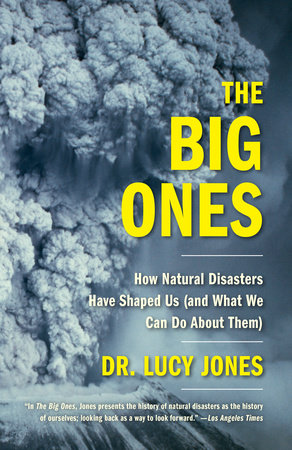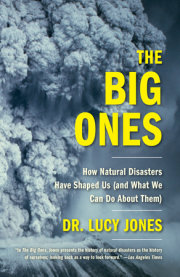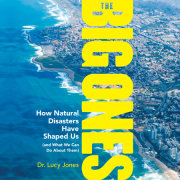Chapter OneBrimstone and Fire from out of Heaven
Pompeii, Roman Empire, AD 79The earth rocked and shook, the bases of the mountains trembled and reeled because of God’s anger.—Psalm 18We all know the story of Pompeii. An eruption of poisonous gases and heavy ash covered the Roman city some two thousand years ago, burying people in their houses, completely wiping out the city in a matter of days. We look back and see the inevitability of the destruction and pity the inhabitants for not knowing better.
Who would build a city on the side of an active volcano? Tourists today visit what might be considered a parable for what happens when you build a community without regard for the threats around you, preserved for our edification and amusement. We assure ourselves we wouldn’t make the same mistake.
Mount Vesuvius is a classic conical volcano rising over four thousand feet above the Bay of Naples. Its shape tells geologists much of what is going on inside. The massive cone demonstrates that lava comes out faster than erosion can wash it away, so it is active now and future eruptions are a certainty on the scale of geologic time. To rise up and form a mountain as it has, and not just flow as a liquid over the landscape, the lava must be fairly sticky (or viscous, to use the technical term). The sticky lava can hold in gases, at least for a while. That means that eruptions can be explosive. Alternating layers of volcanic ash, the result of explosive eruptions, and cooled lava are needed to grow the tallest mountains—a type called stratovolcanoes.
So why build a city here, where the danger is so great? For the same reason that Seattle lies in the shadow of Mount Rainier, Tokyo looks up to Mount Fuji, and Jakarta is encircled by five active volcanoes, including Krakatau: when they aren’t erupting, volcanoes make great homes. Volcanic soils are porous with good drainage and lots of fresh nutrients, producing fertile crops. Deformation of the rocks around a volcano often creates good natural harbors and defensible valleys. Plate tectonics might guarantee that the next event will happen, but which generation will experience the extreme event is determined by chance. And to most human beings, as to the inhabitants of Pompeii in AD 79: if it hasn’t happened to me, it simply hasn’t happened.
*
Vesuvius’s eruption in the sixth century BC led the Osci tribes of that region, and the Roman conquerors who followed, to declare it the home of the god Vulcan. The periodic steam rising from it was a reminder that Vulcan was the smith of the gods, forging their weapons in a celestial furnace. But the volcanic soil was fertile, holding water and supporting some of the richest agriculture of the Roman empire, and so civilization flourished. Six hundred years without an eruption had made Vesuvius seem the definition of safe.
By the beginning of the first century AD, several towns had been built on the side of the volcano, including Pompeii, Herculaneum, and Misenum. The region had been conquered by Rome in the third century BC, and it had become a flourishing, prosperous community. Excavations have found the remains of a thriving commercial center. Frescoes celebrate the craftsmen who wove and dyed cloth, a major local industry. A sprawling, open-air marketplace has been uncovered, complete with restaurants and snack bars. Tax records show that Pompeii’s vineyards were much more productive than those around Rome and their wine was sold across the Empire. (The first known product brand based on a pun is from Pompeii, a jar of wine labeled “Vesuvinum.”)
Wealthy Romans had villas constructed in the area to come enjoy the seaside. Large public markets, houses of worship, and government buildings reflect a community living well above simple subsistence. Many of the houses excavated in Pompeii are spacious and elegant. Beds were found carved out of marble. Some houses had their own baths, and public baths served the community with water brought in from the Roman aqueduct system. Situated at the end of the Amalfi Coast, Pompeii, even then, hosted the glitterati.
It is from this culture that we get our word
disaster—literally, “ill-starred.” To Romans, disasters happened because their fate had been written in the stars. The random nature of disasters, relative to the scale of one human lifetime, creates such a level of fear that all human cultures have come up with some means for ascribing meaning to them. When Shakespeare, in
Julius Caesar, gives Cassius the line “The fault, dear Brutus, is not in our stars, / But in ourselves,” he is speaking against a cultural norm that finds explanation of the unexpected in our fates.
Romans were in the hands not just of destiny but of their capricious gods. Like the Greek before it, Roman mythology portrayed the gods as selfish, careless entities, albeit very powerful ones. Disasters happened to an individual because he got in the way of a spat between these powerful beings. Vulcan, the god of fire, was not physically attractive, but he had been given Venus, the goddess of love, to be his wife. Volcanic eruptions, then, were a sign of his anger when he found out about one of Venus’s infidelities.
This may have provided an explanation for volcanic episodes, but it was not a particularly reassuring one. It left the people powerless in the face of petty gods and their tantrums. So they attempted to soothe Vulcan—to reclaim a sense of control—in their annual feast honoring him. Vulcan represented fire both in its beneficial uses, such as metalsmithing, and in its destructive power, such as in volcanoes and wildfires (the more common threat to grain storage in the heat of the summer). So with the Vulcanalia, held every year on August 23, they placated the god, offering bonfires and sacrifices to keep destruction from being visited upon their harvest.
In AD 79, as the Vulcanalia was being celebrated by unwitting residents of Pompeii, Vesuvius was entering the final phase of what would be one of its largest eruptions. Our knowledge of the eruption comes from two sources. One is, of course, the evidence preserved in the city of Pompeii itself, fifteen miles outside Naples. The ash from the eruption buried the city over the course of a few weeks, completely destroying the community. Ninety percent of the residents escaped alive, but they abandoned the region, and the existence of the city was almost forgotten. The site was rediscovered and excavated in the eighteenth century, including the corpses of the residents who did not escape.
The second source is a young Roman scholar, Pliny, called the Younger, who wrote letters that have come down to us describing the death of his uncle, Pliny the Elder, during the eruption. The younger and elder Plinys were part of Rome’s minor aristocracy, both holding the rank of
equestrian, entitled to be a knight in the army, and were originally from the Lake Como region in northern Italy. Pliny the Elder served in the Roman army, primarily in Germany, for the first two decades of his adulthood. He never married, but his widowed sister came to live with him after he left the army, along with her young son. The son was adopted by his uncle and took his name, and thus came to be called Pliny the Younger. Pliny the Elder was famous in Rome both for his writings and for his close relationship with the emperor Vespasian. While in the army, he wrote a history of the German wars, with details like how to use a horse’s movements to fight with a javelin more effectively. In his later diplomatic career as a ruler of various provinces, he collected information about the history of the regions and their natural features.
Two years before the eruption, Pliny the Elder published his thirty-seven-volume
Naturalis Historiae, “On Natural History,” often called the first encyclopedia. It represented his observations as he traveled the Empire, creating one of the largest literary works to come down to us from Roman times. In the preface, he says that “to be alive is to be watchful,” and we see that passion in the breadth of topics he catalogs. From a modern scientist’s perspective, he may seem a bit credulous (as in, for example, his description of monstrous races of people with the heads of dogs). But he also shows a scientist’s passion for knowledge. He finishes his final volume with the words “Greetings, Nature, mother of all creation, show me your favor in that I alone of Rome’s citizens have praised you in all your aspects.” He seems to have been obsessive about his work, often choosing writing over sleep.
In AD 77, in addition to the release of his
On Natural History, Pliny the Elder was appointed by the emperor to be head of the Roman fleet berthed in the Bay of Naples. The Pliny household moved to Misenum, at the mouth of the Bay of Naples. From their villa, they had a commanding view of Mount Vesuvius on the other side of the bay. Pliny the Elder directed fleet operations as he worked on revisions to his
Natural History. Pliny the Younger was completing his legal training, studying with his uncle, and becoming a prolific chronicler himself.
After the centuries of quiet, the latter part of the first century had seen an increase in earthquakes, with a particularly severe one in AD 62. That earthquake had damaged quite a few houses in Pompeii (even in AD 79, some of them were still being repaired).
Numerous earthquakes were felt and recorded in the next decade, and people began accepting them as a normal part of life. At the Vulcanalia celebrations on August 23, AD 79, Pliny the Younger’s journal entry noted several earthquakes occurring during the day, but he thought nothing of them, “as earthquakes are common in [the region of] Campagnia.” We now know that magma must move from the magma chamber, often several miles deep in the earth, to the surface for an eruption to occur. That movement can be marked by earthquakes, bulging of the earth’s surface, and gas emissions. It can take months, years, or even decades before enough pressure has been built to cause an eruption. (This makes volcanic eruptions more likely to be predicted than many other geological phenomena.)
The next day, August 24, the lives of everyone in Campagnia were turned on end. A little after noon, Vesuvius exploded violently, sending a column of gas and ash high into the sky. Both Plinys observed this from across the Bay of Naples. The Younger wrote, “I cannot give you a more exact description of its appearance than by comparing to a pine tree; for it shot up to a great height in the form of a tall trunk, which spread out at the top as though into branches.”
True to form, Pliny the Elder wanted to see the eruption more closely. He started arranging for vessels of the fleet to help with evacuations and to take him across the bay to make more detailed observations. Pliny the Younger wisely chose to stay at the villa and continue with his schoolwork. As preparations were under way, the Elder received a message from a noblewoman friend whose villa sat in Stabiae at the foot of Vesuvius, begging him to help them escape. He dispatched the galleys to Herculaneum, but he himself took a “fast-sailing cutter.” As they approached Herculaneum, cinders and ash fell so heavily that the ship’s pilot advised returning to Misenum. Pliny replied that “fortune favors the brave,” ordering the pilot to sail for Stabiae, where his friend lived. Winds whipped up by the eruption brought the cutter into port but then made it impossible to leave.
Pliny’s friend and her household were terrified by the eruption and the inability of the ship to navigate the rough seas roiled by the turmoil of the eruption. In her villa, Pliny tried to reassure his friends by feasting, bathing, and sleeping while waiting for the winds to abate. But as the eruption grew worse, it became clear that the winds were not dying down. (They were in fact being generated by the eruption itself, although Pliny obviously did not know that.) They decided to try again to get the ship to sea. They ventured back to the shore with pillows tied to their heads to protect them from the falling volcanic ash and molten rock. The sea was still too rough to board the ships, and the air was so foul as to make breathing difficult. Pliny the Elder was overcome and fell to the ground, unable to rise. His friends finally abandoned him and boarded the ship. They were able to escape and thus give the tale to Pliny the Younger. The friends returned three days later and found the body of Pliny the Elder under ash but with no obvious injury. Most scholars have decided he died from a heart attack, perhaps triggered by noxious gases.
Copyright © 2018 by Lucy Jones. All rights reserved. No part of this excerpt may be reproduced or reprinted without permission in writing from the publisher.










